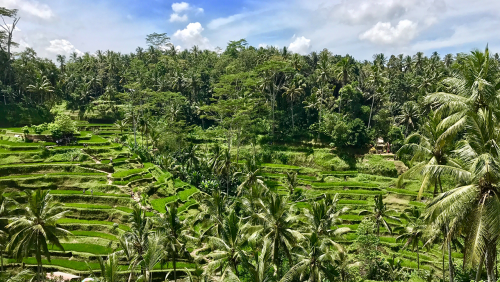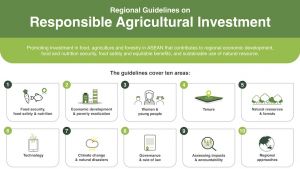Investing in Innovation: Food, Agriculture and Forestry in Southeast Asia

Erin Sweeney provides guest commentary on food, agriculture, and forestry in Southeast Asia.
Introduction
Southeast Asia is a leading agricultural exporter, placing it at the fulcrum of the global food system. It is responsible for 85 percent of global palm oil production, 75 percent of global natural rubber production, and 31 percent of global rice production. It is no surprise then that – as the region becomes increasingly vulnerable to climate change in the face of a world that will double its demand for food by 2050—the hum of interest from investors looking for “responsible” investments in Southeast Asia’s agriculture landscape has grown to an audible buzz.

The ASEAN Guidelines for Responsible Investment in Food, Agriculture and Forestry were developed through an inclusive, multi-stakeholder process with support from the ASEAN Secretariat, Grow Asia, the International Institute for Sustainable Development (IISD), the Swiss Agency for Development and Cooperation (SDC) and World Bank trust fund.
Southeast Asia is a leading agricultural exporter, placing it at the fulcrum of the global food system. It is responsible for 85 percent of global palm oil production, 75 percent of global natural rubber production, and 31 percent of global rice production. It is no surprise then that—as the region becomes increasingly vulnerable to climate change in the face of a world that will double its demand for food by 2050—the hum of interest from investors looking for “responsible” investments in Southeast Asia’s agriculture landscape has grown to an audible buzz.
Questions do, however, remain. While there is interest, investors want to know where to find best projects to invest in, what constitutes “most responsible” in the first place, and, quite rightly so, how they can try to guarantee the Environmental, Social and Governance (ESG) criteria of the investment are met in a region where traceability and transparency across agriculture supply chains are often lacking.
While there are hundreds of credible platforms, partnerships, and third-party accreditors that provide (varied) answers to these questions, we hope this piece helps you cut through the noise and provides some insight on how investors are, and perhaps should be, approaching such investments.
In Search of the Next Big Thing
Given the multiplicity of challenges facing the rural farming economies in Southeast Asia (which also produce the vast majority of agricultural product coming out of the region), start-up ag-tech solutions are positioned to have a positive impact across multiple social, economic and environmental indicators. Around the world, investors are hoping to find the unicorn among companies that meet their goals to do good and simultaneously yield impressive returns.
From Grow Asia’s work in this space, we note several innovative ag-tech solutions emerging from Southeast Asia that are attracting considerable attention. In Myanmar, Tun Yat is improving smallholder farmers’ access to mechanization by allocating tractors more effectively during land preparation, acting as an “Uber” for tractors. In Indonesia, a digital lending platform, CROWDE, has already helped 17,000 farmers access to credit to buy critical inputs at the start of the cropping season.
Looking Within
Other types of investors (i.e. agribusinesses along the supply chain) are looking for innovative ways to leverage their ESG targets for greater returns and, hopefully, de-risked investments. In 2018, Olam International Limited (Olam) finalized Southeast Asia’s first sustainability-KPI-linked revolving credit facility, to pay debts along their agri supply chains. If Olam’s linked projects hit their KPI targets, the interest rate decreases and they demonstrate a strong business case for responsible investing. Similar efforts by national stock exchanges (like the Stock Exchange of Thailand) encourage listed companies to invest responsibly along their supply chains, through ranking and awards systems.
Financial Institutions (FIs) are beginning to look for de-risked opportunities to back innovative projects like Olam’s sustainability-linked loan. Sustainable finance reporting giants like the United Nations Principles for Responsible Investment (PRI), the Sustainability Accounting Standards Board (SASB), and regional partnership efforts—Asia Sustainable Finance Initiative, provide FIs with plenty of information about ESG targets and what to measure. Scoring systems are beginning to rate FIs on their levels of commitment and outcomes on sustainability targets in ASEAN (such as the World Wide Fund for Nature (WWF) SUSBA report). Yet, with domestic banks and non-listed companies still largely dominating the market in the region, these structures may not target nor reach where the majority of the impact occurs.
The Question of Risk
There are of course risks beyond simply failing to meet the return on investment in the ESG model for investors in any sector. Once investors promise compliance, they must grapple with the possibility of human rights violations, land grabs, climate catastrophes, and contract breaches, just to name a few. In the case of working with start-ups, how do investors know these companies can scale their solutions and prove their ESG impact while guaranteeing the target Return on Investment (ROI)?
Given the myriad challenges to getting responsible ROI, international experts are questioning the validity of sustainability efforts among agribusinesses (facing unmet deforestation targets in 2020) and capacity of impact investors to make significant change (recent reviews show “responsible investments” still lack real impact on ESG targets).
Without innovative (and perhaps more importantly, proven) strategies for benchmarking the responsible or ethical practices among investees in the field, the real impact of ESG-linked investments may remain stagnant – and in this era of rapidly changing climate conditions, strategic and successful tactics are required.
Guidelines on Responsible Investment in Food, Agriculture and Forestry (FAF)
We believe that multisectoral, regionally appropriate approaches may provide a solution to the challenge. In Southeast Asia, an innovative approach has been developed that has the potential to create a measurable increase in the quantity and quality of responsible and sustainable private sector investment in Food, Agriculture, and Forestry (FAF) across ASEAN.
In response to rapid urbanization, increased Foreign Direct Investment (FDI), and growing inequality in the region, the Association of Southeast Asian Nations (ASEAN) Secretariat identified a need for such an approach in the FAF. At their request, Grow Asia and its partners—in consultation with over 300 players in the space—developed the ASEAN Guidelines for Promoting Responsible Investment in Food, Agriculture and Forestry (ASEAN RAI Guidelines), the world’s first regionally-contextualized guidance based on the principles established by the Committee on Food Security.
The key purpose of the Guidelines is to promote responsible and inclusive investments in FAF in the ASEAN region that contribute to regional economic development, food, and nutrition security, food safety and equitable benefits, as well as the sustainable use of natural resources. The Guidelines target:
- Establishing favorable conditions to attract responsible investment in FAF through a clear policy and regulatory framework nationally, and a coherent approach across ASEAN;
- Strengthening the capacities of stakeholders, encouraging and enabling investors to meet their obligations, and creating instruments and tools to further cooperation;
- Creating a framework to guide ASEAN member states, large and small investors, and other actors in the development of responsible and sustainable FAF investment and value chains in the region; and
- Agreeing on a set of mutual concerns and interests, which serves as a reference for stakeholders’ decisions, behaviors, and actions.
Grow Asia, together with the ASEAN Secretariat and international organizations and experts, is about to embark on a 10-year implementation plan to test our theory: that multi-stakeholder, locally-contextualized, scalable approaches will most efficiently and effectively drive investment in FAF supply chain solutions and large-scale projects.
Our implementation plan approach is three-pronged:
- Multi-stakeholder: Bolster government, private, and civil society actors’ learning, knowledge and capacity to proactively devise and help apply measures and solutions (by developing and delivering a regional blended learning and accreditation program and hosting on how to operationalize the Guidelines in real-world scenarios.)
- Locally-contextualized: Improve the ability of ASEAN member states to develop national-level legal and policy frameworks, processes, and practices (by providing on-demand legal and policy advisory services to national government officials and delivering bespoke capacity building services for national officials)
- Scalable: Ensure the Guidelines remain an action-oriented, living document that adapts to new learnings and regional trends (by embedding the knowledge and capacity building tactics into a respected business institution that leads future development and training on the Guidelines)
The stakeholders involved in making investments more responsible (from agribusinesses to impact investors to traditional banks) have said they need on-the-ground support to take action. Governments have (for many reasons) not yet widely integrated the responsible requirements into their investment policies, and domestic and SME agri-investors still hesitate to (publicly) adopt or operationalize responsible investing principles. Grow Asia and our partners will leverage the knowledge captured as we implement the ASEAN RAI Guidelines to facilitate the institutionalization of expertise from lived experiences among diverse stakeholders in specific community contexts. We will not provide that support directly, nor create another set of standards for investors to follow.
The ASEAN RAI Guidelines have yet to be proven in the field. But as we launch our 10-year multi-scalar, multi-stakeholder implementation plan at the field level, we will glean learnings about best practices in this innovative strategy for investing. We hope that learnings from ASEAN can be informed and inform responsible investing around the world. Therefore, we ask you to send examples of in-progress or successful investments made in FAF solutions (digital or supply chain projects) that ensured a responsible—multi-stakeholder, locally-contextualized, or scalable—approach. We look forward to learning from international case studies—please reach out and share examples you have supported.